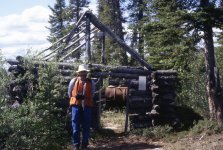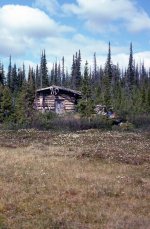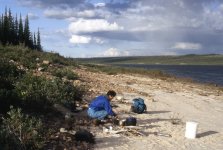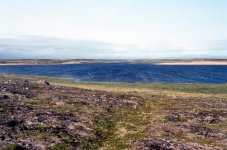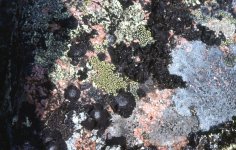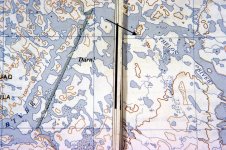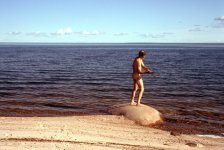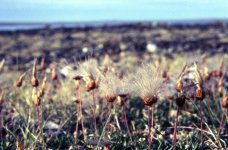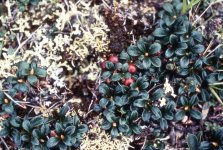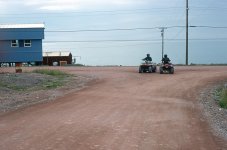- Joined
- Aug 21, 2018
- Messages
- 1,812
- Reaction score
- 4,580
Thanks everyone, for your kind comments!
That's a funny thing about wind, Doug.I once read, but forgot where, that "On a Barren Grounds trip you don't need a compass or map. You just head directly into the wind, and eventually you get to where it is you want to go."
Zac. The plant book we used was Barrenland Beauties by Page Burt. Not an exhaustive botanical treatise by any means, but very helpful:
https://www.amazon.ca/Barrenland-Bea.../dp/0919315259
Now back to the story.

Saturday, July 10
An un-runnable 5-km (3 miles) canyon is a blunt leveller of confident men. We made nine km (5.5 miles) (15.5 miles) today; four by water, five by portage. At three loads each, we traversed 25 km by land. We brought up the packs in stages, leap-frogging each pile spread along the canyon rim. We began portaging at 2:00 pm, and finished at 1:00 am. A 5-km un-runnable canyon swiftly imposes humility on those who believe they have acquired the power of vast space and lurking winds.
Heads bent down beneath heavy packs, we noted two new plants: an Arctic arnica and a yellow lousewort. Heads up, returning to the trailing pile of gear, we saw a Harris' sparrow and a rough-legged hawk. Soaring and circling above the canyon walls, the hawk's thin whistle admonished us for trespassing into its rodent-hunting preserve.

Beneath the packs again, heads humbly bowed to earth, we saw reminders of portaging colleagues of previous years. Campfires of those who failed, or chose not to complete their task in a single day. A broken tent peg - - a fallen and forgotten aluminum plate - - all silent but certain emblems of the true misery of the portage trail.
In the tent at 2:00 am; granola, gorp and sausage for dinner. Much too tired to prepare a hot meal. A 5-km, un-runnable canyon is a formidable challenge, and I'm relieved to be at the end of this portage trail.
Sunday, July 11
Considering our difficult day yesterday, which extended late into the evening, we rose surprisingly early -- 10:00 am. I think anxiety and tension triggered our internal alarms. We had ended our portage 0.5 km before the Clarke River, but access to the Thelon remained difficult. We would need to lower the canoe and packs 15 m (50 feet) down a nearly vertical cliff of eroding, fractured sandstone. I fell asleep last night already thinking that the Clarke would offer easier access to moving water.
A short saunter to the Clarke over mostly open terrain proved easy. Although nearly as steep, the cliff face above the Clarke River was mostly covered with dwarf birch and alder, which offered much more stable footing. Neither of us relished extending our portage by 0.5 km, but the very difficult access to the Thelon Canyon below our camp drove us back into harness.

We first moved our gear about a third of the distance, to a sunny area in the shelter of a thin strip of white spruce, where we prepared a thoroughly leisurely breakfast in the morning warmth. Smothered in butter and jelly, our bannock was the most enjoyable of the trip.
By 4:00 pm, we were moving down the Clarke River, and rejoined the Thelon above a large island with steep cliff faces all around. Picking our way through the shallow riffles and rocks between the island and the left bank, our spirits soared as we faced only one more rapid, purported in the NWT guide as being runnable. No qualifications. Runnable. As we neared the rapid, an ominous ledge, with 2-m souse holes, stretched between both banks. No route was obvious or apparent. We beached our canoe on river-left to scout.
Very dejectedly, we forced our way along the ridge, through spruce swamp and willow bogs.
"I don't want to portage anymore."
The inside bend on river-right was too risky. A run down the centre was unthinkable. On river-left, however, a 1-m strip of water between the shore and the ledge beckoned. Access to the strip was guarded by two successive diagonal waves deflecting into the ledge and companion souse hole. The water wasn't too pushy, though, and the remainder of the run along the canyon wall could be completed in relatively calm water.
Back in the canoe, floating toward the thundering ledge, my mouth, as usual, expressed my worry by drying instantly. We easily crossed the first, small diagonal wave. The second curling crest of water proved larger than anticipated. Slicing across with forward strokes, the bow entered the eddy as the stern dipped precariously into the souse hole. Powering forward, and rocking only slightly, we safely turned up into the narrow eddy.
We had done it! We had avoided the portage. Turning tightly, we rode the eddy line along the canyon, making sure to avoid the water heading left into the undercut cliff.
Ten minutes later, we enjoyed our gorp break at the Hanbury River confluence, before being driven back to the water by the most numerous mosquitoes experienced so far.
At 8:30 pm we were in camp, squatting before our fire, sipping brandy and immensely enjoying a shepherd's pie. Neither of us could remember the last time we had experienced a slow-paced, relaxing dinner.
We had travelled only 12 km (7.5 miles) today, and are about 60 km (37 miles) behind schedule. The arduous upper Thelon is behind us, and virtually no obstacle remains before us for the next couple of weeks. I'm sleepy and tired, but very relaxed.
After many days of wind, storm and anxiety, tonight is calm and peaceful. We are camped just downstream of the Hanbury junction. Yesterday we encountered the Thelon Canyon, where we had expected a portage of perhaps 3 km. Instead, we portaged more than 5 km over difficult terrain, including bogs, willow thickets, spruce stands, huge boulders, and tundra. Scouting the portage, dragging along our hand-held buckets, required about 4 hours for the round trip. We then had two more loads each to carry along the canyon ridge. We completed this transport of gear by leap-frogging one pack ahead, and then returning for the second. Each leg of the portage became progressively more difficult. Eventually, I wasn't even able to stand up beneath the 30-kg loads, unless Michael lifted the packs while I struggled to gain my feet. After 11 hours, I was completely exhausted, and very relieved, when I dropped the last pack at the end of the portage trail.
Well, almost the end of the portage trail. During our scouting along the canyon, we selected a stopping point where we could reach the river only by climbing down a steep, unstable cliff. We camped last night at the top of this cliff, knowing that we faced a very difficult challenge to lower the canoe to the water. This morning we found an easier way to the water's edge about 0.5 km further downstream. So, after breakfast, we finished the portage, loaded the canoe, and set off in quickly-flowing water.
Just before the Thelon joins the Hanbury River, the map indicates a rapid described by the NWT guide as runnable. When we first approached the rapid, we could see only a continuous line of waves curling across the entire river. A good trail led up the cliff, on river-left. Does this path indicate a portage trail? After yesterday's exhausting portage, we weren't prepared to hike up the cliff, push through the willow thickets and spruce, and scramble down the other side. We were very discouraged. Scouting from the trail, we identified a sneak-route on river-left, just wide enough for our canoe to pass in relatively calm water. After skirting by the ledge, we would then need to power to river-left to avoid the curling waves below the drop. We appreciated our river skills and confidence, which allowed us to avoid another day of portaging. Our leans came in particularly handy, as the curling wave momentarily caught and held our stern in the souse hole below the ledge.

We had finally reached the Hanbury River, our quest for these last two weeks. We had hoped to rest on its banks, to celebrate our accomplishment of completing successfully the first third of our Thelon River trip. The afternoon was windy and rainy, and the bugs were the worst we have experienced so far. We continued downstream to our camping spot of tonight.
We celebrated the end of our second week with a relaxing dinner and a glass of brandy. I am entertained by a semi-palmated plover that repeatedly scurries by to "peep" at me. She doesn't seem concerned -- just curious and friendly. One of the nicest parts of this trip is living naturally with all the birds and geese. Quite often, birds perch within eyesight -- so close that binoculars become unnecessary.
(Note: I think I'll stop for now. We have completed the first of three sections of the Thelon River to Baker Lake. It's a good time to take a break. The second of three sections is supposed to be easy. It's the section that most recreational canoeists paddle. Should be more like fun than work.)
That's a funny thing about wind, Doug.I once read, but forgot where, that "On a Barren Grounds trip you don't need a compass or map. You just head directly into the wind, and eventually you get to where it is you want to go."
Zac. The plant book we used was Barrenland Beauties by Page Burt. Not an exhaustive botanical treatise by any means, but very helpful:
https://www.amazon.ca/Barrenland-Bea.../dp/0919315259
Now back to the story.

Saturday, July 10
An un-runnable 5-km (3 miles) canyon is a blunt leveller of confident men. We made nine km (5.5 miles) (15.5 miles) today; four by water, five by portage. At three loads each, we traversed 25 km by land. We brought up the packs in stages, leap-frogging each pile spread along the canyon rim. We began portaging at 2:00 pm, and finished at 1:00 am. A 5-km un-runnable canyon swiftly imposes humility on those who believe they have acquired the power of vast space and lurking winds.
Heads bent down beneath heavy packs, we noted two new plants: an Arctic arnica and a yellow lousewort. Heads up, returning to the trailing pile of gear, we saw a Harris' sparrow and a rough-legged hawk. Soaring and circling above the canyon walls, the hawk's thin whistle admonished us for trespassing into its rodent-hunting preserve.

Beneath the packs again, heads humbly bowed to earth, we saw reminders of portaging colleagues of previous years. Campfires of those who failed, or chose not to complete their task in a single day. A broken tent peg - - a fallen and forgotten aluminum plate - - all silent but certain emblems of the true misery of the portage trail.
In the tent at 2:00 am; granola, gorp and sausage for dinner. Much too tired to prepare a hot meal. A 5-km, un-runnable canyon is a formidable challenge, and I'm relieved to be at the end of this portage trail.
Sunday, July 11
Considering our difficult day yesterday, which extended late into the evening, we rose surprisingly early -- 10:00 am. I think anxiety and tension triggered our internal alarms. We had ended our portage 0.5 km before the Clarke River, but access to the Thelon remained difficult. We would need to lower the canoe and packs 15 m (50 feet) down a nearly vertical cliff of eroding, fractured sandstone. I fell asleep last night already thinking that the Clarke would offer easier access to moving water.
A short saunter to the Clarke over mostly open terrain proved easy. Although nearly as steep, the cliff face above the Clarke River was mostly covered with dwarf birch and alder, which offered much more stable footing. Neither of us relished extending our portage by 0.5 km, but the very difficult access to the Thelon Canyon below our camp drove us back into harness.

We first moved our gear about a third of the distance, to a sunny area in the shelter of a thin strip of white spruce, where we prepared a thoroughly leisurely breakfast in the morning warmth. Smothered in butter and jelly, our bannock was the most enjoyable of the trip.
By 4:00 pm, we were moving down the Clarke River, and rejoined the Thelon above a large island with steep cliff faces all around. Picking our way through the shallow riffles and rocks between the island and the left bank, our spirits soared as we faced only one more rapid, purported in the NWT guide as being runnable. No qualifications. Runnable. As we neared the rapid, an ominous ledge, with 2-m souse holes, stretched between both banks. No route was obvious or apparent. We beached our canoe on river-left to scout.
Very dejectedly, we forced our way along the ridge, through spruce swamp and willow bogs.
"I don't want to portage anymore."
The inside bend on river-right was too risky. A run down the centre was unthinkable. On river-left, however, a 1-m strip of water between the shore and the ledge beckoned. Access to the strip was guarded by two successive diagonal waves deflecting into the ledge and companion souse hole. The water wasn't too pushy, though, and the remainder of the run along the canyon wall could be completed in relatively calm water.
Back in the canoe, floating toward the thundering ledge, my mouth, as usual, expressed my worry by drying instantly. We easily crossed the first, small diagonal wave. The second curling crest of water proved larger than anticipated. Slicing across with forward strokes, the bow entered the eddy as the stern dipped precariously into the souse hole. Powering forward, and rocking only slightly, we safely turned up into the narrow eddy.
We had done it! We had avoided the portage. Turning tightly, we rode the eddy line along the canyon, making sure to avoid the water heading left into the undercut cliff.
Ten minutes later, we enjoyed our gorp break at the Hanbury River confluence, before being driven back to the water by the most numerous mosquitoes experienced so far.
At 8:30 pm we were in camp, squatting before our fire, sipping brandy and immensely enjoying a shepherd's pie. Neither of us could remember the last time we had experienced a slow-paced, relaxing dinner.
We had travelled only 12 km (7.5 miles) today, and are about 60 km (37 miles) behind schedule. The arduous upper Thelon is behind us, and virtually no obstacle remains before us for the next couple of weeks. I'm sleepy and tired, but very relaxed.
After many days of wind, storm and anxiety, tonight is calm and peaceful. We are camped just downstream of the Hanbury junction. Yesterday we encountered the Thelon Canyon, where we had expected a portage of perhaps 3 km. Instead, we portaged more than 5 km over difficult terrain, including bogs, willow thickets, spruce stands, huge boulders, and tundra. Scouting the portage, dragging along our hand-held buckets, required about 4 hours for the round trip. We then had two more loads each to carry along the canyon ridge. We completed this transport of gear by leap-frogging one pack ahead, and then returning for the second. Each leg of the portage became progressively more difficult. Eventually, I wasn't even able to stand up beneath the 30-kg loads, unless Michael lifted the packs while I struggled to gain my feet. After 11 hours, I was completely exhausted, and very relieved, when I dropped the last pack at the end of the portage trail.
Well, almost the end of the portage trail. During our scouting along the canyon, we selected a stopping point where we could reach the river only by climbing down a steep, unstable cliff. We camped last night at the top of this cliff, knowing that we faced a very difficult challenge to lower the canoe to the water. This morning we found an easier way to the water's edge about 0.5 km further downstream. So, after breakfast, we finished the portage, loaded the canoe, and set off in quickly-flowing water.
Just before the Thelon joins the Hanbury River, the map indicates a rapid described by the NWT guide as runnable. When we first approached the rapid, we could see only a continuous line of waves curling across the entire river. A good trail led up the cliff, on river-left. Does this path indicate a portage trail? After yesterday's exhausting portage, we weren't prepared to hike up the cliff, push through the willow thickets and spruce, and scramble down the other side. We were very discouraged. Scouting from the trail, we identified a sneak-route on river-left, just wide enough for our canoe to pass in relatively calm water. After skirting by the ledge, we would then need to power to river-left to avoid the curling waves below the drop. We appreciated our river skills and confidence, which allowed us to avoid another day of portaging. Our leans came in particularly handy, as the curling wave momentarily caught and held our stern in the souse hole below the ledge.

We had finally reached the Hanbury River, our quest for these last two weeks. We had hoped to rest on its banks, to celebrate our accomplishment of completing successfully the first third of our Thelon River trip. The afternoon was windy and rainy, and the bugs were the worst we have experienced so far. We continued downstream to our camping spot of tonight.
We celebrated the end of our second week with a relaxing dinner and a glass of brandy. I am entertained by a semi-palmated plover that repeatedly scurries by to "peep" at me. She doesn't seem concerned -- just curious and friendly. One of the nicest parts of this trip is living naturally with all the birds and geese. Quite often, birds perch within eyesight -- so close that binoculars become unnecessary.
(Note: I think I'll stop for now. We have completed the first of three sections of the Thelon River to Baker Lake. It's a good time to take a break. The second of three sections is supposed to be easy. It's the section that most recreational canoeists paddle. Should be more like fun than work.)
Last edited:


